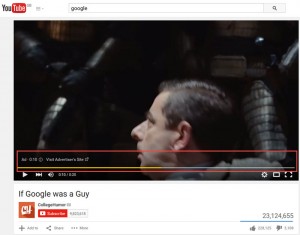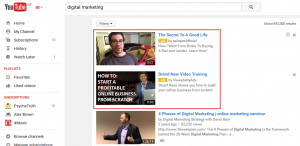The benefit of video advertising on YouTube is that you only pay when someone chooses to watch your video, either by clicking on it or watching the whole thing. This means that your videos are being watched by an audience that you know is interested in what you have to say.
YouTube paid advertising runs through Google AdWords. Just like traditional advertising on AdWords, you choose what you want to spend. It works on a bidding system. For more information on the cost of YouTube advertising and how the bidding system works, here are Google’s own guidelines.
YouTube advertising, also known as TrueView video ads, exist in two forms: In Stream ads and In Display ads.
In Stream TrueView Ads

When a viewer chooses to watch a video on YouTube, the In Stream ads appear at the beginning, like a TV advert. After five seconds, the viewer is given the option to skip the ad. But if it’s engaging and relevant enough, they may choose to watch the whole thing. You only pay if the viewer chooses to watch over 30 seconds of material, or if the video is shorter, you’ll be charged if they view your video to the end. You’ll also pay if they click on the advert to watch your video. You do not pay for the five second preview.
In Stream ads can be used when you want to promote a video content on similar categories. So for instance, if you sell conveyor belts, you could advertise your business to an individual who chooses to view a video on conveyor belt maintenance.
In Display and In Search TrueView Ads

In Display ads can be used to advertise across YouTube, as well as Google’s Display Network. On both mobile and desktop versions of YouTube, your ads are advertised in the search results pages and watch pages. Much like traditional Display advertising, your ads appear as an image with up to three lines of text. When a potential customer clicks on the ad they are redirected to the YouTube watch or channel page to watch it.
For both types of ads you can target different age groups, genders, topics, or interests, so you can reach audiences as big or as small as you like. You can even target keywords or specific videos and channels. However, you need to ensure that certain channels are still opted in for advertising – some big brands remove this option so as not to annoy their customers.
As with free advertising on YouTube, it is still wise to optimise your videos to endure that viewers can read as much information about your business as possible. For more tips on this, take a look at my previous post on YouTube for B2B businesses.




